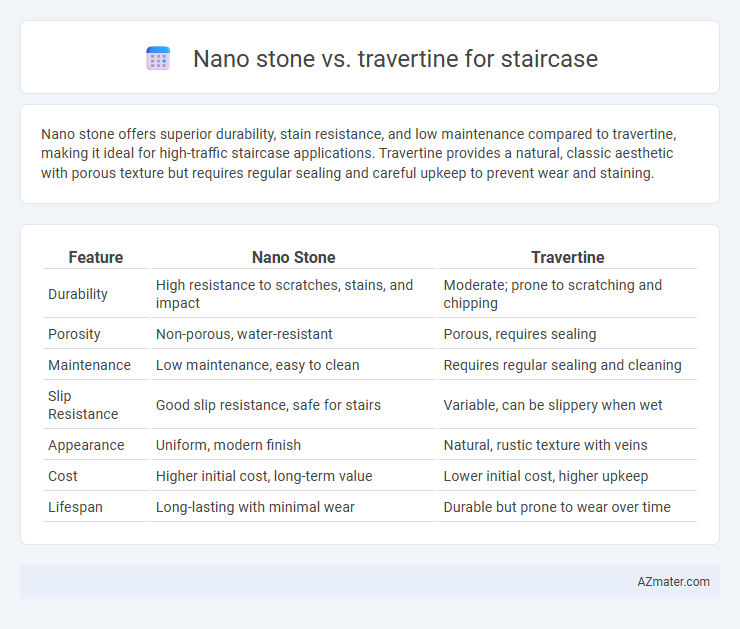Nano stone offers superior durability, stain resistance, and low maintenance compared to travertine, making it ideal for high-traffic staircase applications. Travertine provides a natural, classic aesthetic with porous texture but requires regular sealing and careful upkeep to prevent wear and staining.
Table of Comparison
| Feature | Nano Stone | Travertine |
|---|---|---|
| Durability | High resistance to scratches, stains, and impact | Moderate; prone to scratching and chipping |
| Porosity | Non-porous, water-resistant | Porous, requires sealing |
| Maintenance | Low maintenance, easy to clean | Requires regular sealing and cleaning |
| Slip Resistance | Good slip resistance, safe for stairs | Variable, can be slippery when wet |
| Appearance | Uniform, modern finish | Natural, rustic texture with veins |
| Cost | Higher initial cost, long-term value | Lower initial cost, higher upkeep |
| Lifespan | Long-lasting with minimal wear | Durable but prone to wear over time |
Introduction to Nano Stone and Travertine
Nano stone, an engineered material known for its durability, scratch resistance, and low maintenance, offers a sleek, modern aesthetic ideal for high-traffic staircase surfaces. Travertine, a natural limestone stone recognized for its unique porous texture and warm, earthy tones, provides a classic and elegant look but requires regular sealing to prevent staining. Choosing between nano stone and travertine depends on balancing the need for long-lasting performance with the desire for natural beauty in staircase design.
Composition and Material Properties
Nano stone is an engineered composite primarily composed of natural quartz, resins, and pigments, offering high durability and resistance to scratches and stains, making it ideal for high-traffic staircase surfaces. Travertine, a natural limestone formed from mineral deposits in hot springs, features a porous texture and softer composition, requiring sealing to prevent moisture absorption and wear. The dense, non-porous structure of nano stone ensures superior longevity and low maintenance compared to the more delicate, porous travertine, which is prone to chipping and requires careful upkeep on staircases.
Aesthetic Appearance and Style Options
Nano stone offers a sleek, modern aesthetic with a uniform texture and a wide range of colors, ideal for contemporary staircase designs. Travertine provides a classic, natural look with its porous texture and earthy tones, enhancing rustic or traditional styles with unique veining patterns. Both materials allow for versatile design options, but Nano stone excels in durability and low maintenance while Travertine delivers timeless elegance and warmth.
Durability and Strength Comparison
Nano stone offers superior durability for staircases due to its engineered composition, making it highly resistant to scratches, stains, and impact compared to natural travertine. Travertine, a natural sedimentary rock, is more porous and prone to chipping and wear under heavy foot traffic, requiring regular sealing to maintain strength. The dense, non-porous surface of nano stone ensures long-lasting strength and easier maintenance, making it a more resilient choice for staircase applications.
Slip Resistance and Safety Features
Nano stone offers superior slip resistance compared to travertine, making it a safer choice for staircase surfaces. Its non-porous and textured finish enhances grip, reducing the risk of slips and falls in high-traffic areas. Travertine, while aesthetically appealing, tends to be more porous and smoother, requiring additional treatments to improve its safety features on stairs.
Maintenance and Cleaning Requirements
Nano stone offers superior stain resistance and requires minimal maintenance compared to travertine, which is porous and prone to staining without regular sealing. Travertine demands frequent sealing and gentle cleaning with pH-neutral products to prevent etching and discoloration. Nano stone's non-porous surface allows for easy cleaning with standard household cleaners, making it ideal for high-traffic staircase areas where durability and low upkeep are essential.
Cost Efficiency and Budget Considerations
Nano stone offers superior cost efficiency for staircases due to its durability and low maintenance requirements, reducing long-term expenses compared to travertine. Travertine, while aesthetically appealing, often involves higher initial costs and maintenance investments, making it less budget-friendly for extensive stair applications. Budget considerations lean towards nano stone as a practical choice for minimizing renovation frequency and associated costs.
Installation Process and Practicality
Nano stone offers a streamlined installation process due to its lightweight composition and uniform structure, making it ideal for precise fitting on staircases. Travertine requires more meticulous handling and anchoring because of its natural porosity and variable textures, which can extend installation time and complexity. Practically, nano stone provides enhanced durability and stain resistance, reducing maintenance needs compared to the more porous and softer travertine that may require regular sealing and careful upkeep on high-traffic staircases.
Sustainability and Environmental Impact
Nano stone offers superior sustainability compared to travertine for staircases due to its low water absorption, reduced need for chemical sealants, and longer durability, resulting in less frequent replacements and lower environmental impact. Travertine, a natural sedimentary rock, requires extensive quarrying and chemical processing, contributing to habitat disruption and higher carbon emissions during production. Choosing nano stone supports eco-friendly construction by optimizing resource efficiency and minimizing environmental degradation over the lifecycle of the staircase.
Which is Better for Staircases?
Nano stone offers superior durability and stain resistance compared to travertine, making it a more practical choice for high-traffic staircases. Travertine's natural porous texture can require more maintenance and sealing to prevent damage, which may not be ideal for stairs exposed to frequent use. For staircase applications where longevity and ease of upkeep are priorities, nano stone provides a better balance of strength, aesthetics, and low maintenance.

Infographic: Nano stone vs Travertine for Staircase
 azmater.com
azmater.com